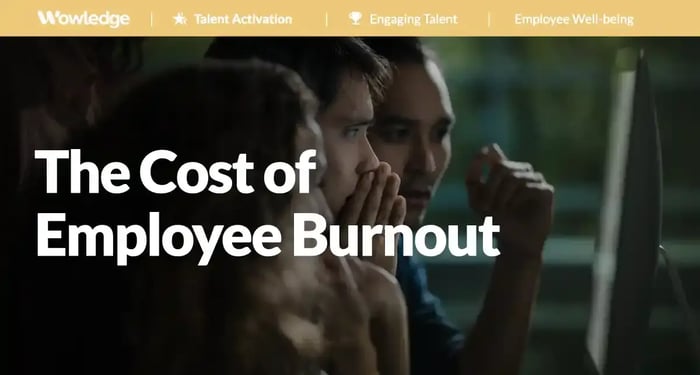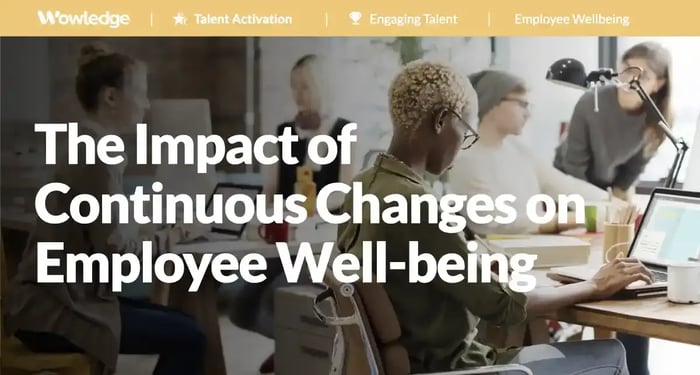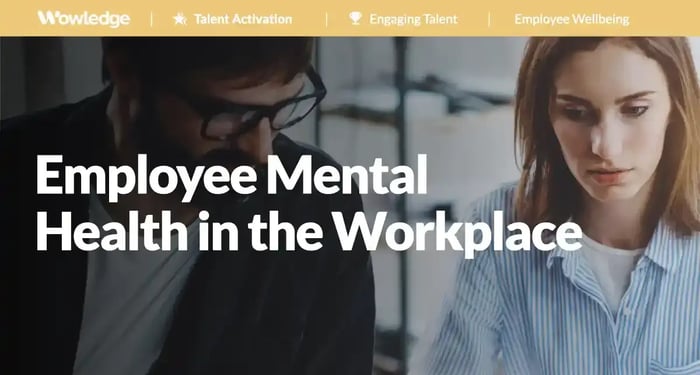Table of Contents
- Factors contributing to burnout
- How Millennials became the “burnout generation”
- The impact of burnout on employees
- The cost of employee burnout on employers
- The need for prioritizing well-being
- Organizational strategies for promoting well-being and preventing burnout
- Employee actions to encourage and support their well-being
- Relevant Practices & Tools
- FAQs
-
“Burnout”, as defined by the APA (American Psychological Association) Dictionary of Psychology, refers to the state of experiencing physical, emotional, or mental exhaustion, which is often accompanied by decreased motivation, lowered performance, and negative attitudes towards oneself and others. The cost of employee burnout is hovering over organizations of all sizes and industries.
The concept of burnout was first identified as a formal diagnosis in 1974 by the psychologist Herbert Freudenberger. Freudenberger himself experienced burnout, due to regularly working ten hours a day in his private practice, followed by a second shift in the free clinic, and subsequent meetings with the staff. After a year of such a regime, he broke down. To understand what happened, he self-analyzed and identified the initial symptoms of burnout. His research laid the groundwork for recognizing burnout as a psychological phenomenon with distinct characteristics.
While the term burnout gained traction in the field of psychology, it wasn't until 2019 that the World Health Organization (WHO) officially classified burnout as an occupational phenomenon. This acknowledgment brought it into the global spotlight, emphasizing the severity of the problem and its potential impact on individuals and organizations alike. The start of a broad burnout problem can be traced back to the impact of the 2008 US recession. During this period organizations slowed down hiring and increased workloads for existing employees, with the focus on “doing more with less”. For employees, fear of losing a job became a driving force behind working longer hours and neglecting the boundaries between personal and professional life. Consequently, work started to become a more significant part of people’s identities, and being continuously busy turned into a perceived “badge of honor.”
One of the key factors contributing to the widespread presence of burnout is the cultural acceptance and even promotion of overworking and the glorification of excessive busyness. The increasing focus on productivity, the blurred boundaries between work and personal life, and the “always-on” culture triggered by technology contributed to burnout. The cost of employee burnout is substantial, and growing.
More than half (59%) of all American workers are experiencing at least moderate levels of burnout. This is nine (9) percentage points higher than what was self-reported in 2021 and two (2) percentage points higher than in August 2020 at the height of the COVID-19 pandemic. What’s most interesting is that 71% Gen Z and 65% Millennials are currently experiencing at least moderate levels of burnout—very high compared to the 38% of Baby Boomers who report experiencing burnout.
The consequences of burnout are far-reaching and impactful. Not only does it affect an individual's well-being and mental health, but it also results in decreased productivity and compromised performance in the workplace. This makes understanding and addressing burnout crucial for both individuals and organizations. Companies must recognize burnout as a serious concern and take proactive measures to create a healthy work environment that values well-being and mental health. On the other hand, employees should be encouraged to prioritize self-care, set boundaries, and seek help if they are experiencing symptoms of burnout.
Factors contributing to burnout
In the modern and fast-paced world, burnout has become a pressing concern affecting employees and businesses. Since burnout is a result of prolonged exposure to stressful work-related factors, it is crucial to identify and understand specific factors that contribute to this problem. Some of the common work-related factors that can lead to burnout include:
Unrealistic workload
When employees are burdened with an overwhelming amount of tasks and insufficient time to complete them, stress levels and the risk of making a mistake naturally rise. To lessen the workload employees might relegate some of their responsibilities to colleagues, further adding to those individuals’ workload, and consequently increasing their stress levels, thus creating a vicious circle. A Gallup report indicated that employees who strongly agree that they always have too much to do are 2.2 times more likely to say they experience burnout very often or always at work.
Lack of clear job expectations
Without a clear understanding of how to be successful in their roles, employees may lack confidence in their contribution. Vague or constantly changing job responsibilities, roles, and expectations can lead to confusion in prioritizing tasks effectively, frustration, and ultimately burnout.
Lack of control and autonomy
When employees feel their opinions and suggestions are not valued, have little say in decision-making, or are micromanaged it can lead to feelings of frustration and powerlessness. Employees might feel their skills and judgment are not trusted and they cannot contribute meaningfully to their work. This sense of disempowerment contributes to burnout.
Long working hours
Regularly extended work hours, including overtime, and lack of work-life balance can leave employees with little time for rest and personal activities. Without adequate breaks and enjoying life outside of work, employees may feel trapped in a never-ending cycle of work, leading to reduced productivity, decreased job satisfaction, and burnout.
Lack of recognition
When employees' efforts and accomplishments are not acknowledged or rewarded, they may experience reduced motivation and commitment. The lack of acknowledgment can create feelings of demotivation among employees, causing them to question the significance of their contributions. Over time, this can lead to a decline in their dedication and obligation to their roles, making them vulnerable to burnout.
Unhealthy work culture
Toxic work environments characterized by high levels of negativity, lack of trust, favoritism, and/or toxic co-workers or managers can significantly contribute to burnout. This type of environment often fosters a constant state of tension, stress, and anxiety, making it difficult for employees to thrive in their roles. A Gallup Report found that when employees strongly agree that they are often treated unfairly at work, they are 2.3 times more likely to experience a high level of burnout.
Isolation at work
Whether isolation is caused by being purposefully excluded from the team by the managers or co-workers or due to the post-pandemic work-from-home arrangements, the feelings of being disconnected and alone commonly reported can be highly stressful and overwhelming. When combined with reduced collaboration and a lack of support, the risk of burnout increases even more.
Lack of growth opportunities
When employees feel “stuck” in their roles without opportunities for advancement or skill development, they may feel trapped. A lack of opportunities to grow can leave employees feeling stagnant and lead to a sense of monotony and disengagement, both of which can significantly contribute to burnout.
Consequences for failure
When employees face unrealistic or constant pressures to perform at exceedingly high levels, failure can considerably impact employees and amplify the cost of employee burnout. The higher the consequences of any failure, the higher the risk of burnout. The fear of making mistakes and facing harsh consequences contributes to emotional exhaustion, higher stress levels, and making employees more vulnerable to burnout.
These factors can vary depending on the company and individual susceptibility to burnout. However, addressing these work-related factors if they appear and fostering a supportive work environment can help to improve overall employee well-being and productivity.

How Millennials became the “burnout generation”
Looking at the landscape of the workforce, it’s evident that Millennials are progressively stepping into managerial positions amounting to 62% of Millennials with direct reports according to Harris Poll research and corroborated by Deloitte’s findings at 60% of workers in that generation. However, Millennials are being referred to as the burnout generation. The book "Can't Even: How Millennials Became the Burnout Generation" by Anne Helen Petersen sheds light on how burnout has taken on a new dimension for millennials. It's no longer about reaching a point of exhaustion but continuously pushing past that point, regardless of the toll it takes on their well-being. The cost of employee burnout is hitting Millennials especially hard.
There are several reasons for this. Millennials grew up with the pressure to achieve success – a message largely reinforced by their Boomer parents' concerns about maintaining middle-class status during economic uncertainties. They were raised to believe that success is synonymous with hard work, and this has led them to internalize the idea that they must optimize themselves for maximum economic performance. This mentality influenced them to become the first generation to view themselves as walking college resumes, ensuring that every activity they undertook could be added to the resume. Higher education became a must, being the sure way to succeed and do well in life. However, this path often burdened Millennials with student debt and unfulfilling careers.
Furthering the issue, a number of behavioral tendencies common to Millennials are aggravating the problem. For example, the rise of freelance and gig economies (as either primary or second jobs) is upping the potential for burnout by blurring the boundaries between work and leisure. The propensity for staying constantly connected has left Millennials feeling guilty for taking time off, along with living with the belief that they should be optimizing every moment of their lives for productivity. Furthermore, the pressure to monetize hobbies and turn personal interests into marketable skills has eroded the concept of leisure purely for its own sake. The idea that every activity must serve a purpose, whether to build one's resume or generate income, has undermined the intrinsic value of leisure time.
Ultimately, the burnout experienced by millennials is a consequence of the increasing gap between the ideals they were raised with—the belief in hard work leading to prosperity—and the reality they face, both in their professional and personal lives. The mix of economic, cultural, and technological factors has fostered an environment in which burnout has become the defining characteristic of a generation that strives to meet impossible expectations.
The impact of burnout on employees
While some may think burnout is only a trendy topic, the research shows it is actually an increasing problem. As previously mentioned, more than half of all American workers experience at least moderate levels of burnout, a percentage that has been on the increase. The effects of such burnout ripple through the lives of employees that extend far beyond their workplaces. The cost of employee burnout can present itself in various ways, from the evident challenges to physical well-being to the complexities of mental health, and the delicate balance between one's personal and professional life.
Physical Consequences
- Fatigue and sleep disturbances: Employees experiencing burnout often suffer from constant fatigue and find it challenging to recharge during sleep. Sleep disturbances, ranging from difficulty falling asleep to disrupted sleep cycles or insomnia can become common, leading to a vicious cycle of exhaustion.
- Weakened immune system: Prolonged stress and burnout can suppress the immune system, making employees more susceptible to infections and illnesses. This not only endangers employee well-being but also translates into increased absenteeism.
- Musculoskeletal issues: Stress-related tension and poor posture resulting from burnout can lead to musculoskeletal problems, such as neck pain, back pain, and headaches decreasing the quality of life and negatively impacting overall work performance.
- Cardiovascular problems: Chronic stress associated with burnout increases the risk of developing cardiovascular issues like high blood pressure and heart disease placing employees at risk of serious health problems.
Mental Health Effects
- Anxiety and depression: Burnout is closely linked to the development of anxiety and depressive symptoms. The constant sense of overwhelm and lack of control can lead to feelings of hopelessness and despair.
- Cognitive impairment: Burnout can affect cognitive function, including memory, attention, and decision-making abilities. Employees may have trouble concentrating and making sound judgments.
- Increased Irritability: Burnout can make individuals more irritable and prone to anger, leading to strained interactions with co-workers, supervisors and customers, and challenging relationships with friends and loved ones.
- Reduced self-esteem and confidence: Employees suffering from burnout may experience a decline in self-esteem and self-confidence due to a perceived inability to cope with work demands.
Personal and Professional Consequences
- Decreased Job Performance: Burnout can significantly impact job performance, leading to reduced productivity, missed deadlines, and increased errors or mistakes.
- Disengagement and Cynicism: Burnout can lead to disengagement from work and feelings of cynicism towards the organization or industry, affecting team dynamics and workplace culture.
- Impaired Interpersonal Relationships: Burnout can strain relationships with colleagues and supervisors, leading to conflicts and decreased collaboration. Employees experiencing burnout often struggle to maintain a healthy work-life balance, neglecting personal relationships and hobbies, which can lead to further isolation and stress.
- Career Burnout: Prolonged burnout may lead employees to question their career choices and contemplate a change in profession or complete disengagement from the workforce.
The cost of employee burnout on employers
Looking across various reports and survey results over the past few years, burnout is seemingly omnipresent. According to Gallup’s findings, 28% of full-time employees reported feeling burned out at work “very often” or “always”. The survey conducted in 2020 by Flex Jobs in partnership with Mental Health America (MHA) found that employed workers are more than three times (3X) as likely to report poor mental health now versus during the pandemic.
Recent research clearly presents us with an uptrend of burnout. Based on research reported in Infinite Potential The State of Workplace Burnout 2023 Report, 38% of the respondents are experiencing burnout, an increase of 3.4% since 2021, on top of the 5.1% increase from 2020 to 2021.
Even though the results focus on individuals, burnout extends beyond employees. It also inflicts significant costs on employers. While employees struggle with physical and mental effects, the repercussions extend to the organization's overall productivity, performance, and financial stability. When burnout is on the rise, the company will face two major cost aspects of employee burnout: decreased productivity and performance, as well as the increase of healthcare and turnover expenses.
Decreased Productivity and Performance
Burnout has a negative impact on employees’ energy and enthusiasm. As employees struggle to cope with burnout, their ability to focus, make decisions, and perform at their best diminishes. Tasks that once were accomplished efficiently may take more time to complete, leading to delays and disruptions in workflow. Moreover, the quality of work often suffers as employees find it challenging to maintain the same level of excellence when dealing with chronic stress and fatigue. According to the Infinite Potential 2023 Workplace Burnout Study, those experiencing burnout are much more likely to report that they are less productive (57%) and that they are producing a lower quality of work (47%).
Burnout also diminishes employees’ desire to learn and grow. Most of their energy and mental focus is on daily survival, not developing for the future. They become resistant to coaching and develop a mindset focused on problems rather than future opportunities and success. Creativity and innovation are suppressed, resulting in missed opportunities for growth and progress. The hidden cost of employee burnout is difficult to assess, but very real.
Gallup reports that employees who say they very often or always experience burnout at work are: 63% more likely to take a sick leave, 2.6 times as likely to be actively seeking a different job, and are 13% less confident in their performance. The impact of reduced productivity and poor performance can hinder an organization's competitiveness and success in the market. The global economy bears a cost of $1 trillion every year due to lost productivity attributed to depression and anxiety disorder. In essence, when employees are underperforming, the organization’s overall effectiveness is also compromised.
Increased Healthcare and Turnover Costs
Burnout not only affects the immediate work environment but also has an impact on healthcare and employee turnover costs. Prolonged stress and burnout can lead to physical and mental health issues among employees including cardiovascular problems, anxiety, and depression. As employees seek medical attention to address these health concerns, healthcare costs for employers go up. A study by Harvard and Stanford professors found that burnout can cause between $125 billion to $190 billion in healthcare costs related to psychological and physical problems. While healthcare costs continue to rise for those with chronic conditions, costs are even higher. Employers spend 2.5 times (2.5X) more on employees with one chronic condition and over 5 times (5X) more for those with two or more chronic conditions. Additionally, employees may take more sick days to recover or cope with the effects of burnout and its associated illnesses.
Burnout also plays a crucial role in employee turnover, as disengaged and overwhelmed workers are more likely to seek employment elsewhere, leading to recruitment, training, and onboarding expenses for the organization. The turnover of just one employee can cost an employer 1.5 – 2 times their salary. However, it’s estimated that two-thirds of all sunk costs due to turnover are intangible, including lost productivity and knowledge. The loss of experienced and skilled employees further disrupts team dynamics and hinders work unit productivity.
Burnout imposes significant costs on employers, impacting productivity, performance, and the organization's financial results. The decline in productivity, along with reduced quality of work and lowered creativity, threatens an organization's ability to thrive in a competitive environment. Furthermore, the increase in healthcare costs and employee turnover stretch the company's resources.

The need for prioritizing well-being
The impact of burnout on employees is far-reaching, affecting not only their physical health but also their mental well-being and professional life. It is the employee's responsibility to take proactive steps to manage stress and seek support when needed to prevent burnout and maintain their overall health and happiness. However, organizations must also take responsibility to recognize and address burnout as a serious issue, implementing supportive policies and promoting a healthy work environment. The positive news is that more than half (57%) of employees believe their organizations care about their overall well-being at least a moderate amount, which is a strong foundation for employers to build upon.
Creating a culture of well-being is becoming a crucial factor for maintaining employee satisfaction and productivity as a driver of a company’s financial results and future growth. By demonstrating that the organization values its employees as individuals, not just as workers, employees feel cared for and supported. They are more likely to feel a sense of loyalty to the organization, leading to higher retention rates.
A culture that encourages a healthy work-life balance and provides opportunities for professional growth contributes to increased productivity and reduces the cost of employee burnout. Employees are better able to focus on their tasks, make better decisions, and contribute effectively to team goals. With this comes better communication and improved interactions among team members. When employees are given a chance to be mindful about both their own and their colleague’s well-being it creates a supportive environment in which it is easier to share ideas, seek help, or overcome challenges together. A well-being-centered culture allows employees to reach their full potential. Employees who are not stressed or burned out are more likely to be innovative and come up with new ideas. Additionally, when employees feel their well-being is valued, they are more willing to embrace change and contribute to the organization's success in a fast-paced business environment.
Furthermore, organizations that prioritize well-being often develop a positive reputation within their industry. In a competitive job market, such organizations have an advantage when it comes to attracting and retaining top talent. Potential employees are more likely to be interested in workplaces with a healthy work environment, work-life balance, and opportunities for personal and professional growth. Employees who are already in the organization are more likely to stay long-term, contributing to the stability of the company.
Creating a culture of well-being is not just a trend to hop on, it's an essential step for organizations who want to thrive in today’s dynamic business world. Since burnout comes from the work cultures created by people, organizations can reinvent the way employees work. They can reorganize the work culture in ways that are beneficial for their employees, for example by:
- Offering flexible work arrangements – recognizing that employees have diverse needs and responsibilities outside of work, offering flexible work arrangements can contribute to their overall well-being. This might include options like remote working and flexible hours, allowing employees to better balance their professional and personal lives.
- Promoting work-life balance – encouraging employees to take breaks, use their vacation days, and disconnect from work outside of business hours promotes a healthier work-life balance. Managers should ensure that constant connectivity does not negatively impact employees’ ability to recharge.
However, the most important aspect is leading by example. Cultivating a culture of well-being begins at the top. When leaders and managers prioritize their own well-being, it sets a positive tone for the entire organization. This, in turn, encourages employees to follow suit and lessen guilt when they prioritize their personal well-being.
Managers play a pivotal role in shaping the well-being culture within their teams and organizations. A recent study conducted by The Workforce Institute found that managers have just as much of an impact on people’s mental health as their spouse (both 69%)—and even more of an impact than their doctor (51%) or therapist (41%). The same study uncovered that:
- More than 80% of employees would rather have good mental health than a high-paying job.
- Two-thirds of employees would take a pay cut for a job that better supports their mental wellness—and 70% of managers would, too.
Evidently, leaders and managers must address the issue of burnout so they can retain a productive and healthy workforce and achieve their business goals. Nevertheless, organizations cannot forget about the leaders themselves when creating well-being strategies. The burnout has significantly impacted executive and senior management since 2020 with 14% of executive and senior management experienced burnout in 2020, and that number increasing to 34% in 2022.
By adopting a holistic approach that includes the organization at all levels, the company can address the problem and create effective strategies to mitigate the adverse effects of burnout.

Organizational strategies for promoting well-being and preventing burnout
AFLAC’s 2022 report found that the overwhelming majority of employees agree that mental health coverage is as important as major medical coverage, yet only 61% of employees have access to mental health care as part of their benefits package. The issue is even more prominent in small businesses, with merely 54% of employees indicating that they have access to mental health coverage.
With employee demands for mental health coverage and support on the rise, it’s only a matter of time before a greater number of employers will have to play a more significant role in promoting well-being and preventing burnout among their employees. Creating a positive work environment that prioritizes employee wellness can lead to increased productivity, job satisfaction, and overall organizational success. Here are strategies companies can implement to support their employees better:
1. Foster a supportive culture
Cultivate a culture that values employee well-being and mental health by incorporating open communication, active listening, empathetic leadership, and destigmatizing discussions about stress, burnout, and mental health issues.
2. Provide resources for mental health
Offer access to mental health resources such as Employee Assistance Programs (EAPs), counseling services, and workshops on stress management and resilience. Create an environment where employees feel comfortable seeking help when needed. Train managers to identify the first symptoms of stress and burnout, so that employees feel supported, and action is taken at the earliest.
3. Promote work-life balance
Encourage employees to maintain a healthy work-life balance by setting clear expectations for work hours and respecting boundaries. Implement policies that discourage after-hours emails and meetings and offer flexible work arrangements when feasible. Encourage employees to take regular breaks during the workday and throughout the year.
4. Create clear job roles and expectations
clearly define roles, responsibilities, and expectations for each employee. Regularly assess employees' workloads and ensure they have the necessary resources to complete tasks effectively. Recognize and reward employees' hard work and accomplishments.
5. Provide opportunities for feedback
Create a structure for employees to provide feedback on their workload, work environment, and overall well-being. This feedback can shed light on what type of improvements and adjustments should be incorporated to enhance employee well-being.
6. Lead by example
Company leadership should model healthy work habits and behaviors. When leaders prioritize their own well-being and demonstrate the importance of work-life balance, it sets a positive tone for the entire organization helping others to mold the same behaviors.
Research continues to demonstrate the impact of implementing solid programs and policies in support of employee well-being. According to the Centers for Disease Control and Prevention (CDC), implementing effective health programs can lead to 25% savings on absenteeism, healthcare costs, and workers’ compensation and disability management claims costs. Additionally, Harvard conducted a study that found that absenteeism costs are reduced by about $2.73 for every dollar spent on wellness programs, and medical costs are reduced by about $3.27 for every dollar spent. That shows how big an impact wellness programs can have on employees, organizations, and their overall performance.

Employee actions to encourage and support their well-being
Achieving the best outcomes requires that employees not solely lean on their company but also proactively act for their own welfare. Here are some effective strategies to encourage employees to adopt:
1. Prioritize self-care
Self-care involves engaging in activities that rejuvenate one’s mind, body, and spirit. This can include regular exercise, a sufficient amount of sleep, nutritious eating, and engaging in activities and hobbies that bring joy. It is important to allocate time for self-care without feeling guilty since those self-care activities are essential to recharging one’s energy.
2. Set boundaries
Establish clear boundaries between work, personal life, and technology. Setting limits on work hours, checking emails during off-hours, or taking on too many commitments to ensure the individual has time to relax and disconnect.
3. Stay organized
Effective time management and organization can prevent feelings of being overwhelmed. It can be done by using tools like calendars, to-do lists, and task management apps to plan the days and prioritize tasks. Incorporating short breaks throughout the workday gives an opportunity to regularly rest, stretch, and recharge.
4. Practice mindfulness and meditation
Mindfulness and meditation techniques can help to stay present, manage stress, and improve overall well-being. Regular practice can reduce anxiety, enhance focus, and increase the ability to handle challenging situations.
5. Incorporate physical activity
Engaging in regular physical activity not only improves physical health but also has positive effects on mental well-being. Exercise releases endorphins, which are natural mood boosters and stress relievers.
6. Engage in positive social connections
Nurturing relationships with friends, family, and colleagues can provide emotional support and a sense of belonging. Spending quality time with loved ones and engaging in meaningful conversations can boost the mood and help prevent burnout.
7. Pursue passion projects
Engaging in activities that represent personal passions outside of work can provide a sense of accomplishment and joy. Whether it's a creative endeavor, a hobby, or volunteering, these activities positively contribute to a balanced life.
8. Seek professional help
Therapy or counseling can provide valuable tools to manage stress and prevent burnout and helps the tackling of issues in a constructive way. Individuals should proactively seek help from a mental health professional when encountering feelings of being overwhelmed, stressed, or experiencing symptoms of burnout.
Well-being is an ongoing process that requires consistent effort. Implementing a range of strategies can help to foster a healthier and more balanced lifestyle, reduce the risk of burnout, and enhance the overall quality of life for employees. As such, prioritizing well-being within the workplace has emerged as an imperative for organizations that aspire to foster a thriving and productive workforce, as the positive effects of focusing on employee well-being ripple throughout the organization. Enhanced job satisfaction and engagement are just the starting points - individuals who feel supported and valued are not only more committed to their roles, but they also bring a higher level of creativity and innovation to their work. This shift translates to an increase in overall productivity, propelling the organization forward in an increasingly competitive landscape.
Moreover, the financial implications are undeniable. By addressing burnout, organizations can witness a substantial reduction in healthcare costs and turnover rates, saving the organization significant resources otherwise spent on healthcare utilization, recruitment, training, and onboarding.
People have a clear need for certain psychosocial needs to be met in the workplace and it is the organization’s responsibility that their employees feel valued and acknowledged and their contributions recognized. Comparing individuals unaffected by burnout to those experiencing it, the former:
- Exhibit a 49% increase in engagement.
- Report a 50% higher sense of psychological safety.
- Feel a 30% greater sense of belonging.
- Experience a staggering 217% increase in perceived organizational support
As a result, addressing employee well-being and avoiding burnout is an investment that promises remarkable returns, both for individuals and the organizations they comprise.
Relevant Practices & Tools
Emerging HR Strategy Practices for Engaging Employees and External Partners Now and Into the Future. >
Emerging HR Strategy defines a future centered around optimizing how employees and their needs are managed and how key external resources and relationships... more »
Creating an Employee Experience that Bonds High Performers to the Organization. >
Employee experience constitutes the entire journey an employee takes with the organization. This includes everything from pre-hire to post-exit interactions... more »
Designing a Communication and Engagement Strategy that Involves Employees and Establishes Trust in the Changes. >
Effective communication and engagement strategies employ Fair Process research, which shows that people care not only about an initiative’s outcomes but also about the decision-making... more »
Creating Group Coaching and Mentoring Programs to Broaden and Syndicate the Potential for Impact. >
As a coaching and mentoring culture progresses, its effect is felt throughout the organization. The key at this level is to syndicate the use of coaching and mentoring deeper... more »
The Managers Guide to Performance Conversations Tool: Conduct and Record Regularly Occurring Manager-Employee Performance Conversations. >
A guide and template for leading regular manager-employee conversations regarding performance over a short (e.g., 1-4 weeks) period of time... more »
FAQs
What are the earliest measurable signs of employee burnout that leaders can monitor?
Early signals appear before performance drops: rising after-hours messaging, shrinking PTO usage, increased meeting hours per person, slower work cycle times, and more errors/rework. Pair these operational signals with a short monthly pulse on the employee’s perception of their energy level, workload fairness, and role or goal clarity. If three or more indicators trend negatively for 60–90 days, treat it as a risk event. Escalate to a workload review and create a remediation plan with the manager and team.
What belongs in a burnout prevention policy?
Codify and communicate norms and expectations for working hours, limit exempt off-hours and non-exempt overtime work hours, after-hours communications, and meeting hygiene management standards. Define escalation paths when workload exceeds capacity (who can stop work, who re-prioritizes). List available supports—EAP, counseling, manager check-in cadence—and clarify privacy expectations. Commit to quarterly reviews with employee input so the policy evolves with the business.
How do we calculate the ROI of a burnout prevention program?
Build a simple model with three measures 90 days after implementing the program: productivity recapture (hours regained × output per hour), avoided turnover (1.5–2× salary per retained employee), and reductions in healthcare claims or (non-preventive) utilization. Pilot in one high-risk unit for 90 days with a matched control group and measure changes in those two groups. Convert improvements to annualized dollars and net them against program costs (training, EAP upgrades, manager time). Most organizations see break-even within one to two quarters when they target high-burnout hotspots.
Which KPIs should the executive team use to hold managers accountable for well-being?
Use a compact set that leaders can influence weekly: regrettable turnover, tardiness/absenteeism rates, PTO balance use, after-hours message volume, error/rework rates, and a quarterly employee pulse survey index (e.g., combined energy, belonging, and goal achievability ratings). Track trend changes rather than raw scores to account for different team baselines. Require each manager to publish a workload plan and recognition cadence, then tie a slice of variable pay to improvement. Review KPIs in business ops meetings, not just HR forums, to keep ownership broad.










